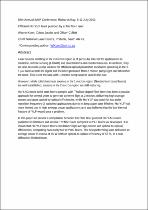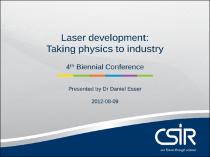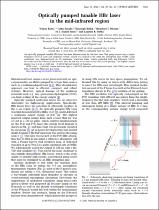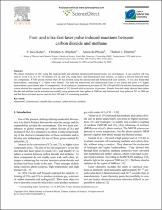JavaScript is disabled for your browser. Some features of this site may not work without it.
- ResearchSpace
- →
- Research Publications/Outputs
- →
- Conference Publications
- →
- View Item
| dc.contributor.author |
Koen, W

|
|
| dc.contributor.author |
Jacobs, Cobus

|
|
| dc.contributor.author |
Collett, O

|
|
| dc.date.accessioned | 2014-07-30T09:22:48Z | |
| dc.date.available | 2014-07-30T09:22:48Z | |
| dc.date.issued | 2013-07 | |
| dc.identifier.citation | Koen, W, Jacobs, C and Collett, O. 2013. Efficient Ho:YLF laser pumped by a Tm:fiber laser. In: 58th Annual SAIP Conference, Richards Bay, 8-12 July 2013 | en_US |
| dc.identifier.uri | http://hdl.handle.net/10204/7544 | |
| dc.description | 58th Annual SAIP Conference, Richards Bay, 8-12 July 2013 | en_US |
| dc.description.abstract | Laser sources emitting in the 2 micron region is of particular interest for applications in medicine, remote sensing (LIDAR) and directed infra-red countermeasures. In addition, they are also desirable pump sources for efficient optical parametric oscillators operating in the 3-5 µm band as both the signal and the idler generated from 2 micron pump light can fall within the band. This is not the case with 1 micron pump sources used in the past. However; while solid state laser sources in the 1 micron region (Neodymium based lasers) are well established, sources in the 2 micron region are still maturing. Ho:YAG based solid-state lasers pumped with Thulium-doped fibre lasers has been a popular approach for several years to generate coherent light at 2 micron, delivering high average powers and good optical-to-optical efficiencies, while Ho:YLF was used for low pulse repetition frequency Q-switched applications due to its long upper state lifetime. Ho:YLF had more limited use in high average power applications as it was believed that the low thermal fracture of YLF would pose a problem. In this paper we present a comparison between Tm:fiber laser pumped Ho:YAG lasers published in literature and several Tm:fiber laser pumped Ho:YLF lasers we developed. It is shown that Ho:YLF based lasers can deliver high average powers and optical-to-optical efficiencies, comparing favourably to Ho:YAG lasers. The best performing laser delivered an average power in excess of 45 W with an optical-to-optical efficiency of 53 %, in a near diffraction limited beam. | en_US |
| dc.language.iso | en | en_US |
| dc.relation.ispartofseries | Workflow;13089 | |
| dc.subject | Laser sources | en_US |
| dc.subject | Fiber laser | en_US |
| dc.subject | YLF laser | en_US |
| dc.subject | Ho:YLF based lasers | en_US |
| dc.subject | Ho:YAG based solid-state lasers | en_US |
| dc.subject | Thulium-doped fibre lasers | en_US |
| dc.title | Efficient Ho:YLF laser pumped by a Tm:fiber laser | en_US |
| dc.type | Conference Presentation | en_US |
| dc.identifier.apacitation | Koen, W., Jacobs, C., & Collett, O. (2013). Efficient Ho:YLF laser pumped by a Tm:fiber laser. http://hdl.handle.net/10204/7544 | en_ZA |
| dc.identifier.chicagocitation | Koen, W, Cobus Jacobs, and O Collett. "Efficient Ho:YLF laser pumped by a Tm:fiber laser." (2013): http://hdl.handle.net/10204/7544 | en_ZA |
| dc.identifier.vancouvercitation | Koen W, Jacobs C, Collett O, Efficient Ho:YLF laser pumped by a Tm:fiber laser; 2013. http://hdl.handle.net/10204/7544 . | en_ZA |
| dc.identifier.ris | TY - Conference Presentation AU - Koen, W AU - Jacobs, Cobus AU - Collett, O AB - Laser sources emitting in the 2 micron region is of particular interest for applications in medicine, remote sensing (LIDAR) and directed infra-red countermeasures. In addition, they are also desirable pump sources for efficient optical parametric oscillators operating in the 3-5 µm band as both the signal and the idler generated from 2 micron pump light can fall within the band. This is not the case with 1 micron pump sources used in the past. However; while solid state laser sources in the 1 micron region (Neodymium based lasers) are well established, sources in the 2 micron region are still maturing. Ho:YAG based solid-state lasers pumped with Thulium-doped fibre lasers has been a popular approach for several years to generate coherent light at 2 micron, delivering high average powers and good optical-to-optical efficiencies, while Ho:YLF was used for low pulse repetition frequency Q-switched applications due to its long upper state lifetime. Ho:YLF had more limited use in high average power applications as it was believed that the low thermal fracture of YLF would pose a problem. In this paper we present a comparison between Tm:fiber laser pumped Ho:YAG lasers published in literature and several Tm:fiber laser pumped Ho:YLF lasers we developed. It is shown that Ho:YLF based lasers can deliver high average powers and optical-to-optical efficiencies, comparing favourably to Ho:YAG lasers. The best performing laser delivered an average power in excess of 45 W with an optical-to-optical efficiency of 53 %, in a near diffraction limited beam. DA - 2013-07 DB - ResearchSpace DP - CSIR KW - Laser sources KW - Fiber laser KW - YLF laser KW - Ho:YLF based lasers KW - Ho:YAG based solid-state lasers KW - Thulium-doped fibre lasers LK - https://researchspace.csir.co.za PY - 2013 T1 - Efficient Ho:YLF laser pumped by a Tm:fiber laser TI - Efficient Ho:YLF laser pumped by a Tm:fiber laser UR - http://hdl.handle.net/10204/7544 ER - | en_ZA |









